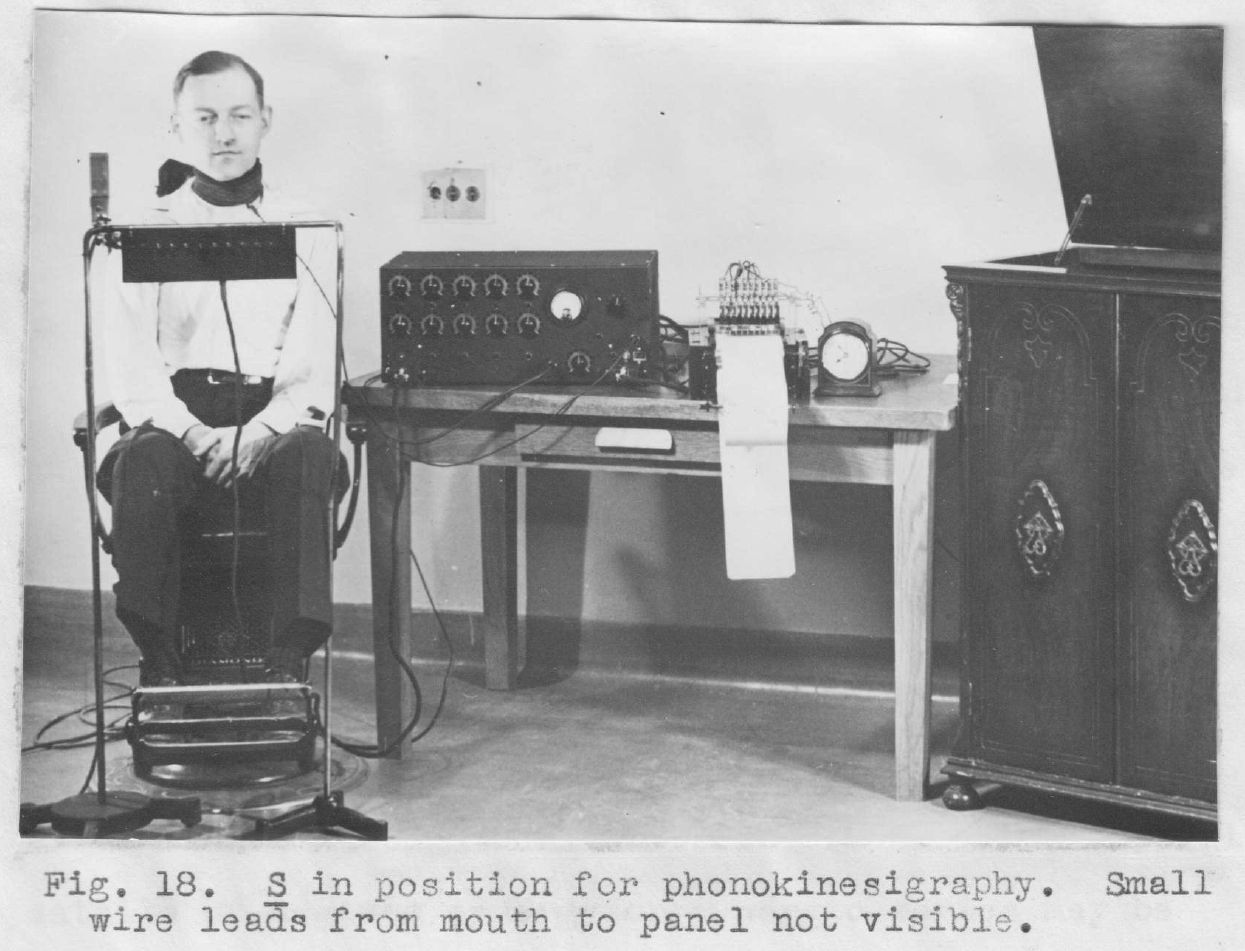A history of EPG

Photograph: Taken from the PhD thesis of Herbert Koepp-Baker 1938 (Courtesy of Iowa State University – Graduate College)
The technique of dynamic palatography stemmed from the desire of phonetic scientists to reveal the pattern and timing of contact between the tongue and the hard palate. This insight into lingual articulation during speech along with its ease of interpretation and reliability has made the electropalatograph an essential piece of speech laboratory instrumentation for the last 40 years.
Static palatometry has been has been used for 200 years with the earliest known reference dating back to 1803. Static palatometry involves a mixture of cocoa powder and charcoal applied to the tongue . After production of a single speech sound, the tongue and palate are photographed – this method is still used in academic field work for tribal language studies.
In Germany in 1930, Schilling first combined an electrical sensor with static palatography to mark on an audio recording the instant that the static palatograph image was taken. . Electropalatography proper was however born in the US in 1938 when Herbert Koepp-Baker (later to be the Reverent Koepp-Baker) developed the “phonokinesigraph” as a phd student at the Graduate College of State of Iowa. This instrument consisted of an artificial palate 1/23″ thick made of shellac with up to ten electodes connected to an amplification system and data was recorded as continuous contact traces on a paper chart.
Throughout the early 60’s, experimental systems for measuring dynamic linguo-palatal contact based on completing an electrical circuit were developed by laboratories in Russia, Japan, and the USA. In 1964, Kydd and Belt at the University of Washington, USA built the forerunner of the modern electropalatograph based on DC circuits. In 1968 Shibata at University of Tokyo was the first to build an electropalatograph using AC circuits but using pairs of contacts.
In the late 1960’s Professor Hardcastle in Edinburgh and Professor Fletcher in Utah developed versions of the Kydd and Belt system. By the mid seventies Professor Hardcastle had moved from Edinburgh University to Reading University, Professor Fletcher had moved to the University of Alabama and the basic instrument design had evolved to more-or-less its current form in three independent laboratories at the University of Reading, UK, the University of Alabama, USA and at the University of Tokyo, Japan, using the combination of a Kydd and Belt system but with AC circuits which allowed more contact points to be measured and improved the reliability of the measures.
These three labs created commercial electropalatography products manufactured and marketed by Rion Co., Japan, Kay Elemetric Inc., USA and Reading University respectively. The three systems differ essentially in the design of the artificial palates, with the Reading palate being based on 62 contacts in an acrylic palate held in place by clips round the teeth, the Kay palatometer system using 96 contacts in a vacuum formed palate which covers the teeth and the Rion palate having 63 contacts formed on a flexible circuit embedded in acrylic held by clips round the teeth. The Kay palatometer is no longer manufactured due in part to the prohibitively high cost of making pseudopalates for this system. The Rion system too has been discontinued. Following the termination of production by Kay in 1998, Professor Fletcher started his own company to develop and promote the palatometer.
The original Reading EPG system [1][2](1974-78), designed by Wilf Jones and Peter Roach in consultation with Prof Hardcastle, interfaced to a PDP-8 computer at the Reading University Phonetics Lab and was programmed in machine code by Peter Roach. The system went on to be reprogrammed to work with a desktop Commodore personal computer. With the advent of the IBM compatible PC in the 1980’s, the software was rewritten by Wilf to run under the DOS operating system. In order to adapt the EPG to the IBM PC an interface card was required which had to be plugged into one of the expansion bus slots. In the late 1980’s, the EPG and the computer card were modified for a second time to allow an audio signal to be recorded and displayed with the EPG data. In 2000, the software was rewritten to run under the Windows operating system and the interface card was dispensed with in favour of an external interface unit.
[1] Roach, P.J. and Hardcastle, W.J. `A computer system for the processing of electropalatographic and other data’, in M.Tatham (ed.) Proceedings of the Vth. Phonetics Symposium , pp. 127-142, University of Essex (1976). [2] Hardcastle, W.J. and Roach, P.J. `An instrumental investigation of coarticulation in stop consonant sequences’ in H.H. and P. Hollien (eds.) Current Issues in the Phonetic Sciences, pp. 533-550, Amsterdam, John Benjamins. (1979)